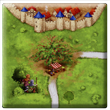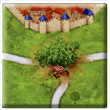The Fruit-Bearing Trees
 |
You are reading the rules for this tile design. |  |
| If your tiles have a different design, then choose a game from Spin-offs. |  |
With this expansion, Carcassonne will be surrounded by various fruit-bearing trees. The larger the variety of fruits you offer is, the higher your income will be.
General info and comments
The Fruit-Bearing Trees was released in C2 (the 2nd edition) in March 2018 by HiG. A C3 (the third edition) version was released in April 2024, which has cities with clipped buildings. This expansion was never officially released for C1 (the 1st edition).
Contents
- 6 new land tiles with 6 types of fruit-bearing trees (quince, apple, apricot, cherry, plum and elder)
- 24 fruit tokens (4 per fruit with the values 5, 4, 3, and 2 on the back)
Rules
Preparation
Shuffle the 6 Land tiles with fruit-bearing trees together with the Land tiles of the basic game. Arrange the 24 fruit tokens according to their colour/type. Then, shuffle each colour/type stack separately (the values face down). Place the 6 stacks next to the scoring track.
Gameplay
1. Placing a tile
When you draw a Land tile with a fruit-bearing tree (Tree tile), you place it according to the normal rules. Then, you place a stack with 4 fruit tokens (of the same fruit type) on top of the Tree tile with the values still face down. You can choose the related type of fruit, however, it does not matter which type of fruit you put there, in terms of the game. Thus, any tree and any type of fruit may be combined!
2. Placing a meeple
You may place one of your meeples on the Tree tile according to the normal rules. Note that you are not allowed to place a meeple on the tree itself.
Performing a "fruit action"
If you have deployed a meeple, you may now perform either one of the following two fruit actions explained below: Harvesting or Selling.
If you place a land tile next to the tree tile in another turn (vertically, horizontally or diagonally) and place a meeple on this land tile, you may carry out one of the fruit actions as well. [1] [2] [3]
- Harvesting
- Selling
Special case: If there are several fruit trees next to the meeple you have just placed, you can still only perform one action. However, you are free to choose which tree you want to harvest from. [4]
Harvesting
Take the top-most fruit token from the tree tile (if available). Then, immediately score points according to the fruit token's value. The fruit token is then placed in front of you.
Selling
Instead of taking a new fruit token, you can choose to sell fruit tokens you have previously harvested. You may sell 1 to 4 tokens, but the more you sell, the more points you score. If you want to sell more than one token, they must (all) be of different types of fruit. You may only sell one set at a time. The value on the back does not matter when selling fruits. Sold fruit tokens are set aside and removed from the game.
| Points for fruit selling | |
|---|---|
 |
1 token = 3 points |
 |
2 tokens = 6 points |
 |
3 tokens = 10 points |
 |
4 tokens = 15 points |
The following examples show harvesting and selling actions:

Later you place a tile next to the apple tree again and you place a meeple. Now, you want to sell. Up to now, you have harvested 2 apple tokens, 1 apricot and 1 cherry token. You sell three different tokens for 10 points. As you are only allowed to sell one set at a time you keep one apple token.
3. Scoring a feature
When you complete one or more areas (e.g. a monastery, a road etc.) by placing a Tree tile, you score them according to the normal rules.
Final Scoring
At the end of the game, each fruit token is worth 1 point.
Tile distribution
C3 edition
This edition altered the position of the highwaymen in the tile marked with *. The highwaymen expected behind the little tree and the bushes (bottom left) walked away to the fruit-bearing tree.
For each fruit type, there are four tokens with different values (2, 3, 4 and 5) on the back.
C2 edition
For each fruit type, there are four tokens with different values (2, 3, 4 and 5) on the back.
Footnotes
For Icons explanation and licensing please visit Icons page.
- ↑
 A fruit action may happen when:
A fruit action may happen when:
- A tree tile is placed with a meeple (in the same turn); or
- A new tile with a meeple is placed adjacent to a tree tile (in a later turn). It does not matter who placed the tree tile.
- The rules require the placement of a meeple: The meeple placement can happen as first or second figure (the phantom). The placement of a special figure or a neutral figure or a token does not count.
- The fruit action is optional: A player may comply with the given requirements but decides not to perform a fruit action.
- ↑
 The rules to trigger a fruit action require the direct placement of a meeple during phase 2. Placing a meeple on the tile just placed. This will rule out other meeple placement mechanics:
The rules to trigger a fruit action require the direct placement of a meeple during phase 2. Placing a meeple on the tile just placed. This will rule out other meeple placement mechanics:
- Placements to other tiles but the one just placed during the right phase:
- Magic portals (
 Exp. 3 - The Princess & the Dragon)
Exp. 3 - The Princess & the Dragon) - Acrobat placement on an adjacent tile (
 Exp. 10 - Under the Big Top)
Exp. 10 - Under the Big Top) - Flying machines (
 Mini #1 - The Flying Machines)
Mini #1 - The Flying Machines)
- Magic portals (
- Placements to the tile just placed during other phases:
- Wagon movement (
 Exp. 5 - Abbey & Mayor)
Exp. 5 - Abbey & Mayor) - Deployment from the City of Carcassonne (
 Exp. 6 - Count, King & Robber)
Exp. 6 - Count, King & Robber) - Crop circles (
 Mini #7 - The Crop Circles)
Mini #7 - The Crop Circles) - Deployment to a bathhouse (
 The Barber-Surgeons)
The Barber-Surgeons)
- Wagon movement (
- Placements to other tiles during other phases:
- Deploying a meeple to a monastery with a Synod gift card (
 The Gifts)
The Gifts) - Moving a meeple with a Change Position gift card (
 The Gifts)
The Gifts) - Moving a meeple into a city with a drawbridge (
 The Drawbridges)
The Drawbridges)
- Deploying a meeple to a monastery with a Synod gift card (
 Exp. 4 - The Tower and
Exp. 4 - The Tower and  The Phantom.
The Phantom.
- Placements to other tiles but the one just placed during the right phase:
- ↑
 Note that fruit actions take place during phase 2. Placing a meeple. Therefore, these actions will happen as usual even if later actions in the turn sequence may remove the meeple from the tile, for example, being eaten by the dragon (
Note that fruit actions take place during phase 2. Placing a meeple. Therefore, these actions will happen as usual even if later actions in the turn sequence may remove the meeple from the tile, for example, being eaten by the dragon ( Exp. 3 - The Princess & the Dragon).
Exp. 3 - The Princess & the Dragon).
- ↑
 This paragraph was added in C3. This special case wasn't included in the original C2 rules by HiG.
This paragraph was added in C3. This special case wasn't included in the original C2 rules by HiG.
Without this limitation, the interpretation of the original C2 rules suggested that a player could execute one fruit action per tree present on the newly placed tile or any adjacent ones and each meeple placed on this turn part (up to two if placing a any meeple plus a phantom).







































